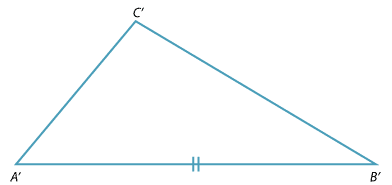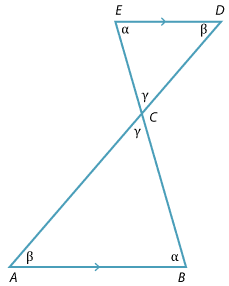![]()
AAA similarity test
If two angles of one triangle are respectively equal to two angles of another triangle, then the two triangles are similar.
If two triangles have two pairs of equal angles, then their third pair is also equal because the angle sum of a triangle is 180°. Thus two such triangles are called equi-angular, and the test is often referred to as the AAA similarity test.
Proof
Let \(\triangle ABC\) and \(\triangle PQR\) be triangles with \(\angle A = \angle P = \alpha\) and \(\angle B = \angle Q = \beta\).
Enlarge \(\triangle ABC\) to \(\triangle A^\prime B^\prime C^\prime\) by a suitable enlargement factor so that \(A^\prime B^\prime = PQ\).
Then \(\angle A^\prime = \alpha\) and \(\angle B^\prime = \beta\) because angles are preserved by enlargements.
Hence \(\triangle A^\prime B^\prime C^\prime\) is congruent to \(\triangle PQR\) by the AAS congruence test. So \(\triangle ABC\) is similar to \(\triangle PQR\), because an enlargement of \(\triangle ABC\) is congruent to \(\triangle PQR\).
Example 1
Prove that \(\triangle ABC\) is similar to \(\triangle DEC\).
Solution
In the triangles \(ABC\) and \(DEC\)
So \(\triangle ABC\) is similar to \(\triangle DEC\) (AAA similarity test).
Note that it is only necessary to show that two pairs of matching angles are equal. The third pair are necessarily equal because the angles of a triangle add to 180°.






